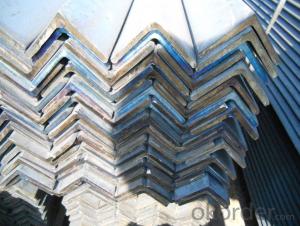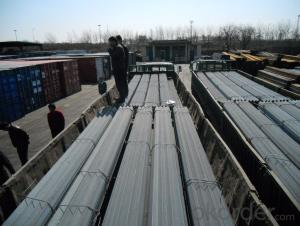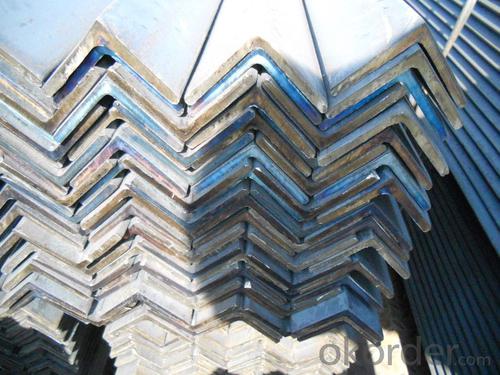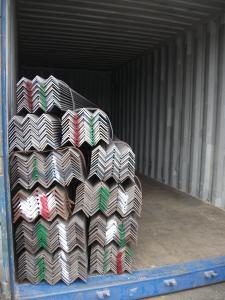Structure Steel Equal Angle Bar
- Loading Port:
- China Main Port
- Payment Terms:
- TT or LC
- Min Order Qty:
- -
- Supply Capability:
- -
OKorder Service Pledge
OKorder Financial Service
You Might Also Like
Product Description:
OKorder is offering Structure Steel Hot Rolled Angle Bar at great prices with worldwide shipping. Our supplier is a world-class manufacturer of steel, with our products utilized the world over. OKorder annually supplies products to European, North American and Asian markets. We provide quotations within 24 hours of receiving an inquiry and guarantee competitive prices.
Product Applications:
Trusses;
Transmission towers;
Telecommunication towers;
Bracing for general structures;
Stiffeners in structural use.
Product Advantages:
OKorder's Structure Steel Hot Rolled Angle Bar are durable, strong, and resist corrosion.
Main Product Features:
· Premium quality
· Prompt delivery & seaworthy packing (30 days after receiving deposit)
· Corrosion resistance
· Can be recycled and reused
· Mill test certification
· Professional Service
· Competitive pricing
Product Specifications:
1.Standards:GB,ASTM,BS,AISI,DIN,JIS
2.Invoicing on theoretical weight or actual weight as customer request
3.Material: JIS G3192,SS400;SS540.
4. Payment terms:
1).100% irrevocable L/C at sight.
2).30% T/T prepaid and the balance against the copy of B/L.
3).30% T/T prepaid and the balance against L/C
5.Sizes:

EQUAL ANGLES SIZES |
| ||
a(mm) | a1(mm) | thickness(mm) | length |
25 | 25 | 2.5---3.0 | 6M/12M |
30 | 30 | 2.5---4.0 | 6M/12M |
38 | 38 | 2.5 | 6M/12M |
38 | 38 | 3.0---5.0 | 6M/12M |
40 | 40 | 3.0---6.0 | 6M/12M |
50 | 50 | 3 | 6M/12M |
50 | 50 | 3.7---6.0 | 6M/9M/12M |
60 | 60 | 5.0---6.0 | 6M/9M/12M |
63 | 63 | 6.0---8.0 | 6M/9M/12M |
65 | 65 | 5.0---8.0 | 6M/9M/12M |
70 | 70 | 6.0---7.0 | 6M/9M/12M |
75 | 75 | 5.0---10.0 | 6M/9M/12M |
80 | 80 | 6.0---10.0 | 6M/9M/12M |
90 | 90 | 6.0---10.0 | 6M/9M/12M |
100 | 100 | 6.0---12.0 | 6M/9M/12M |
120 | 120 | 8.0-12.0 | 6M/9M/12M |
125 | 125 | 8.0---12.0 | 6M/9M/12M |
130 | 130 | 9.0-12.0 | 6M/9M/12M |
140 | 140 | 10.0-16.0 | 6M/9M/12M |
150 | 150 | 10---15 | 6M/9M/12M |
160 | 160 | 10---16 | 6M/9M/12M |
180 | 180 | 12---18 | 6M/9M/12M |
200 | 200 | 14---20 | 6M/9M/12M |
5. Material Specifications:
Grade | Yield Strength,N/mm² | Extension Strength N/mm² | |||
Thickness of Steel,mm | |||||
≦16 | >16-≦40 | >40-≦100 | >100 | ||
SS330 | ≧205 | ≧195 | ≧175 | ≧165 | 330-430 |
SS400 | ≧245 | ≧235 | ≧215 | ≧205 | 400-510 |
SS490 | ≧285 | ≧275 | ≧255 | ≧245 | 490-610 |
SS540 | ≧400 | ≧390 | - | - | ≧540 |
Packaging & Delivery of Angle Steel
1. Transportation: the goods are delivered by truck from mill to loading port, the maximum quantity can be loaded is around 40MTs by each truck. If the order quantity cannot reach the full truck loaded, the transportation cost per ton will be little higher than full load.
2. With bundles and load in 20 feet/40 feet container, or by bulk cargo, also we could do as customer's request.
3. Marks:
Color mark: There will be color marking on both end of the bundle for the cargo delivered by bulk vessel. That makes it easily to distinguish at the destination port.
Tag mark: There will be tag mark tied up on the bundles. The information usually including supplier logo and name, product name, made in China, shipping marks and other information request by the customer.
If loading by container the marking is not needed, but we will prepare it as customer request.
FAQ:
Q1: Why buy Materials & Equipment from OKorder.com?
A1: All products offered byOKorder.com are carefully selected from China's most reliable manufacturing enterprises. Through its ISO certifications, OKorder.com adheres to the highest standards and a commitment to supply chain safety and customer satisfaction.
Q2: How do we guarantee the quality of our products?
A2: We have established an advanced quality management system which conducts strict quality tests at every step, from raw materials to the final product. At the same time, we provide extensive follow-up service assurances as required.
Q3: How soon can we receive the product after purchase?
A3: Within three days of placing an order, we will begin production. The specific shipping date is dependent upon international and government factors, but is typically 7 to 10 workdays.
Q4: What makes stainless steel stainless?
A4: Stainless steel must contain at least 10.5 % chromium. It is this element that reacts with the oxygen in the air to form a complex chrome-oxide surface layer that is invisible but strong enough to prevent further oxygen from "staining" (rusting) the surface. Higher levels of chromium and the addition of other alloying elements such as nickel and molybdenum enhance this surface layer and improve the corrosion resistance of the stainless material.
Q5: Can stainless steel rust?
A5: Stainless does not "rust" as you think of regular steel rusting with a red oxide on the surface that flakes off. If you see red rust it is probably due to some iron particles that have contaminated the surface of the stainless steel and it is these iron particles that are rusting. Look at the source of the rusting and see if you can remove it from the surface.
Images:

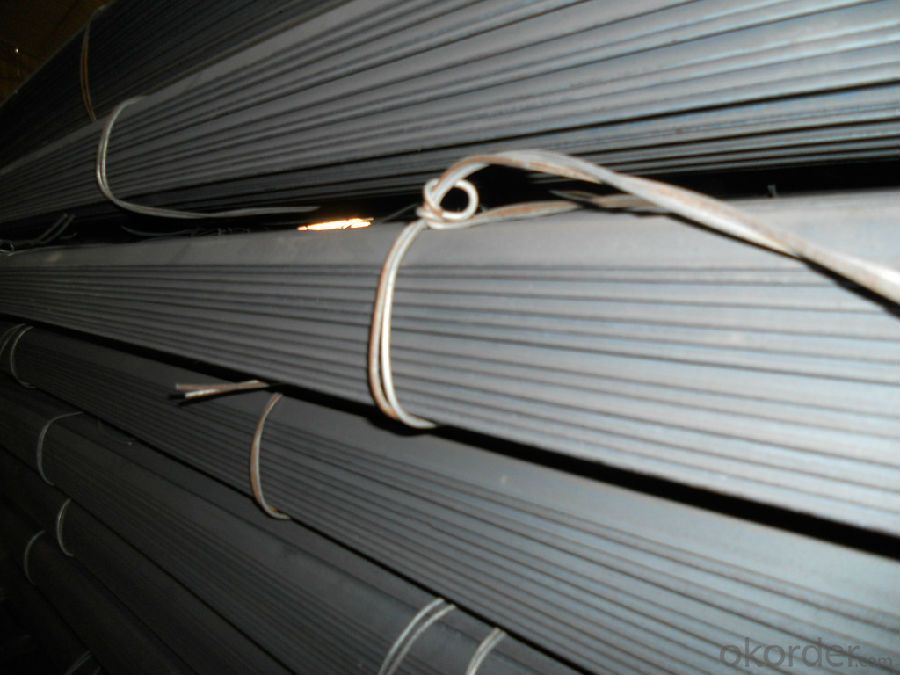
- Q: Can steel angles be used in automotive applications?
- Yes, steel angles can be used in automotive applications. Steel angles are commonly used in the automotive industry for various applications such as frames, chassis, supports, brackets, and reinforcements. This is because steel angles offer high strength, durability, and resistance to impact and vibrations, making them suitable for withstanding the harsh conditions and demanding loads experienced in automotive applications. Additionally, steel angles can be easily welded or bolted together, providing flexibility in designing and constructing automotive components. Overall, steel angles are a reliable and cost-effective choice for automotive applications due to their strength, versatility, and ability to withstand the rigorous demands of the industry.
- Q: What are the common welding techniques for steel angles?
- There are several common welding techniques that can be used for steel angles: 1. Stick welding, also known as Shielded Metal Arc Welding (SMAW), is a popular choice. It involves using a consumable electrode coated in flux, which creates a protective shield around the weld pool. SMAW is versatile and can be used for steel angles of various thicknesses. 2. Gas Metal Arc Welding (GMAW), also known as MIG welding, is another technique that uses a continuous wire electrode and a shielding gas, typically a mixture of argon and carbon dioxide. GMAW allows for high welding speeds and provides good control over the weld pool, making it suitable for steel angles. 3. Flux-Cored Arc Welding (FCAW) is similar to GMAW, but instead of a shielding gas, it utilizes a flux-filled wire. When heated, the flux creates a protective gas shield that prevents contamination of the weld. FCAW is especially useful for outdoor welding or in windy conditions. 4. Gas Tungsten Arc Welding (GTAW), also known as TIG welding, is a precise and clean welding process. It uses a non-consumable tungsten electrode and a shielding gas, usually argon. GTAW produces high-quality welds on steel angles, making it a preferred choice for thin angles or when aesthetics and control are important. 5. Submerged Arc Welding (SAW) is a semi-automatic or automatic welding process that involves feeding a continuous wire electrode and a granular flux into the weld zone. The flux covers the weld, preventing atmospheric contamination. SAW is commonly used for thicker steel angles and provides high deposition rates. It is crucial to select the appropriate welding technique based on the specific requirements of the steel angle joint, such as thickness, joint design, and desired weld quality. Additionally, proper preparation, including cleaning and preheating if necessary, is essential to ensure successful welds on steel angles.
- Q: Can steel angles be used in modular construction?
- Yes, steel angles can be used in modular construction. Steel angles are commonly used in modular construction as they provide structural support and stability. They can be used to create frames, beams, and columns, which are essential components in modular construction. Steel angles are known for their strength and durability, making them well-suited for withstanding the loads and stresses that modular buildings may experience. Additionally, steel angles can be easily fabricated, cut, and welded to meet the specific requirements of a modular construction project. Overall, steel angles are a versatile and reliable choice for modular construction applications.
- Q: Are steel angles available in pre-galvanized form?
- Yes, steel angles are available in pre-galvanized form.
- Q: How are steel angles protected against UV degradation?
- Steel angles are protected against UV degradation through the application of protective coatings, such as paint or galvanization. These coatings act as a barrier, preventing direct exposure to sunlight and thereby reducing the risk of UV degradation.
- Q: How do you calculate the bending capacity of a steel angle?
- In order to determine the bending capacity of a steel angle, several factors must be considered. The initial step involves calculating the moment of inertia (I) of the angle section, which measures its resistance to bending. The moment of inertia relies on the angle's shape and dimensions, and can be found in the manufacturer's specifications or through calculations. Once the moment of inertia has been obtained, the section modulus (Z) can be calculated as another indicator of the section's ability to resist bending. The section modulus is found by dividing the moment of inertia by the distance from the centroid of the section to the extreme fiber. Subsequently, it is necessary to establish the maximum allowable bending stress (σ) for the steel angle. This value is typically provided by the manufacturer or can be determined based on the desired safety factor and the type of steel being used. Lastly, the bending capacity (M) of the steel angle can be calculated by utilizing the formula M = σ * Z. This calculation provides the maximum moment that the angle can endure without experiencing excessive bending stress. It is important to note that these calculations assume the angle's behavior is elastic and do not account for additional factors such as local buckling, residual stresses, or combined loading. Therefore, it is advisable to consult relevant design codes or guidelines for a more comprehensive analysis to ensure the safety and reliability of the steel angle in a specific application.
- Q: What is the standard size of steel angles?
- Steel angles come in a range of sizes that vary depending on the region and industry standards. Generally, they are available in equal and unequal leg lengths, with the equal leg angles typically sized between 20mm and 200mm. The thickness of the angle can also vary, typically falling between 3mm and 20mm. However, it is crucial to understand that these measurements may differ based on the specific application or project requirements. To determine the correct size of steel angles for a particular project, it is recommended to consult industry standards or manufacturers.
- Q: What are the different types of connections used for steel angles in residential applications?
- There are several different types of connections used for steel angles in residential applications. Some of the most commonly used ones include: 1. Welded connections: This is the most common type of connection used for steel angles. It involves welding the angle to the adjacent structural members, such as beams or columns. Welded connections provide excellent strength and rigidity, making them ideal for residential applications. 2. Bolted connections: Bolted connections involve using bolts and nuts to secure the steel angle to the adjacent members. This type of connection is often used when the angle needs to be easily removable or adjustable. Bolted connections are less rigid than welded connections but still provide sufficient strength for residential applications. 3. Clip connections: Clip connections are typically used to connect steel angles to wood or other non-steel materials. They involve using clips or brackets that are attached to the angle and then fastened to the adjacent material using screws or nails. Clip connections are commonly used in residential framing applications. 4. Gusset plate connections: Gusset plate connections are used when two steel angles need to be connected at a joint. A gusset plate, which is a flat plate of steel, is welded or bolted to the angles to provide additional support and rigidity. This type of connection is often used in residential roof trusses and other structural applications. 5. Cleat connections: Cleat connections involve using a steel plate, called a cleat, that is bolted or welded to the steel angle and the adjacent member. Cleat connections are commonly used when the angle needs to be attached to a horizontal member, such as a floor or roof joist. These are just a few examples of the different types of connections used for steel angles in residential applications. The choice of connection type will depend on factors such as the structural requirements, ease of installation, and the type of materials being connected.
- Q: How do steel angles contribute to sustainable construction?
- Steel angles contribute to sustainable construction in several ways: 1. Durability: Steel angles are made of a highly durable material that can withstand extreme weather conditions and have a long lifespan. This reduces the need for frequent repairs or replacements, minimizing waste and resources. 2. Recyclability: Steel angles are 100% recyclable, meaning that at the end of their life cycle, they can be melted down and reused to make new steel products. This reduces the demand for virgin steel production, which is energy-intensive and contributes to greenhouse gas emissions. 3. Structural efficiency: Steel angles provide excellent structural support, allowing for the creation of lighter and more efficient building designs. This reduces the amount of material needed for construction, minimizing the overall environmental impact. 4. Energy efficiency: Steel angles can be easily integrated into energy-efficient building systems. They are often used in the construction of sustainable buildings, such as green roofs, solar panel installations, and energy-efficient facades, which help reduce energy consumption and promote a greener environment. Overall, steel angles contribute to sustainable construction by offering durability, recyclability, structural efficiency, and energy efficiency, making them an environmentally friendly choice for builders and architects.
- Q: Can steel angles be bolted or fastened together?
- Indeed, it is possible to bolt or fasten steel angles together. In construction and structural applications, steel angles are frequently employed to furnish support and stability. To connect them, a variety of techniques may be utilized, including welding, drilling, or the implementation of specialized connectors such as angle brackets or gussets. The act of bolting or fastening steel angles together grants the structure extra resilience and rigidity, thereby enhancing its stability and fortifying it against external forces.
Send your message to us
Structure Steel Equal Angle Bar
- Loading Port:
- China Main Port
- Payment Terms:
- TT or LC
- Min Order Qty:
- -
- Supply Capability:
- -
OKorder Service Pledge
OKorder Financial Service
Similar products
Hot products
Hot Searches
Related keywords
